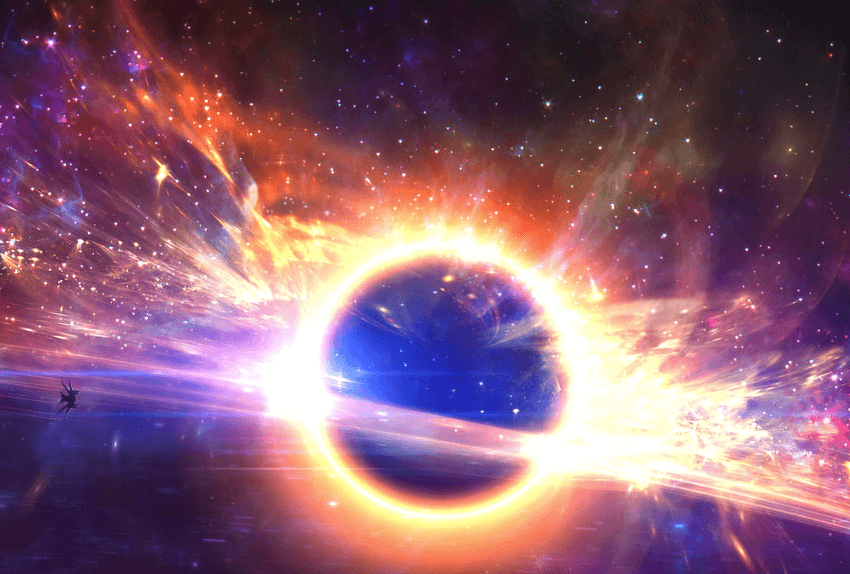This day and age, the evidence of black holes are undeniable even if they are invisible. But between X-ray and radio observations, gas infall/velocity measurements, and stellar orbits in galactic centers, can we have a true account of the number or the density of their distribution? And as new evidence collects every day, this time a merger’s gravitational waves detected by LIGO, is it possible to know how many black holes exist?
A simple approach might be to take a look and simply add up the amount we see. Let’s start there. Able to identify hundreds of X-ray point sources, each one a far away galaxy, the telescope at Chandra X-ray Observatory can detect even a single photon from extreme distances. Analyzing the energy spectrum received from these photons, we find that in the center of these galaxies is a supermassive black hole.
So, now we know there is at least one black hole for every galaxy, of which there could be as many as 10 trillion or more, but does a galaxy have more black holes than the one, even one that’s billions of solar masses large?
As previously mentioned LIGO, the Laser Interferometer Gravitational-Wave Observatory at Caltech has recently recorded evidence of a black hole merger, the third humans have detected. The robust gravitational waves given off by these events originate from binary black hole systems, separate from the galaxy centers we’ve already accounted for. At its current ability, LIGO can, on average, detect a similar signal about 6 times a year, so we can assume that binary black holes are fairly common, with maybe a dozen or so in each Milky Way-sized galaxy. Even more, X-ray information tells us that there are low-mass black hole binaries, probably more than LIGO, which mostly picks up high mass black holes, can detect.
Let’s see where we are in our count: 1 supermassive black hole, a couple dozen medium-to-high mass black hole binaries, and hundreds of low-mass binaries. But that doesn’t even take into consideration any single black holes outside of binary systems, which is probably most of the black hole population. Some estimations have the instances of isolated black holes in the thousands but adding these up makes a difficult job even harder.
As you may suspect by now, the detection of black holes is not easy. Most of the instrumentation we have for this task are only able to recognize the most distant, most immense, or most active specimens. Therefore, the ‘let’s look and see’ approach only reveals a fraction of the number of black holes present in the Universe.
However, all hope is not lost for our endeavor to count the black holes. Because we know how black holes are formed, we can estimate their number and their spread across the Universe. Black holes are formed in one of three ways: a supernova from a star between 20 and 40 stellar masses, a neutron star collision, or a direct collapse of a star 25 times the size of the Sun.
Knowing this information, we can look locally at nearby stars and judge whether they have what it takes to become black holes. When we do this, we find that only 0.1- 0.2% of stars could become a supernova, and those that form binary systems don’t show black hole potential. As a result of the, nearly all the 400 billion stars in the Milky Way will never create black holes.
Still, a few of them will and, similarly, a great number of stars in the past already did. As stars form, they range greatly in mass from a few of the high mass stars that go on to supernova to the disproportionally more low mass, M-class, red dwarf, stars, which make up about 75% of the Milky Way’s population. However, in the past, there were much more, and larger, star-forming fields than there is today.
In fact, the largest star-forming region currently in our local group, 30 Doradus, has thousands of blue stars with the potential to go supernova, up to 30%, while the rest will form neutron stars. Since there used to be numerous similar regions, mostly in spiral arms and at the center of galaxies, and as we see evidence of neutron stars, in gamma rays and pulsars, we can assume there are black holes there as well. Now, we can begin to map out where black holes can be expected.
Studying the Fermi all-sky map, indicating sources of gamma-rays points, and taking all the other data gathered from previous materials, our map of black holes would show over 100 million objects with a concentration near galactic centers, fairly spread apart, and possessing a galactic bulge, not unlike most galaxies.
As you can see, black holes are common, as common as the stars we can see and track easily. Because the Universe has had a long lifespan, 95% of the very high mass stars that form black holes have already died and 25% of those became black holes and still exist in our galaxy and many like it.
Even with this information, there is still a great deal more needed to get a precise count of every black hole. Until direct imaging is possible, the best idea we can get of how many black holes there are and where they are located is to look at the stars we can see and, be using what we know from our indirect data, images, and observation of star activity, assume for every star we see, there is at least one black hole we cannot see. It’s the best science can figure for a phenomenon we are not capable of seeing.
Article Via FORBES / Astrophysicist author Ethan Siegel
More News to Read
- It Appears Hydrogen Energy Isn’t Really as Green as Everyone Makes Out
- Researchers Come Up With New, Lean, Green, Power Generating Machine
- Is Reality Real or is it Simply An Illusion?
- A New Large Hadron Collider Discovery Adds Strangeness to the Already Strange
- Tesla Passed BMW in Market Value











